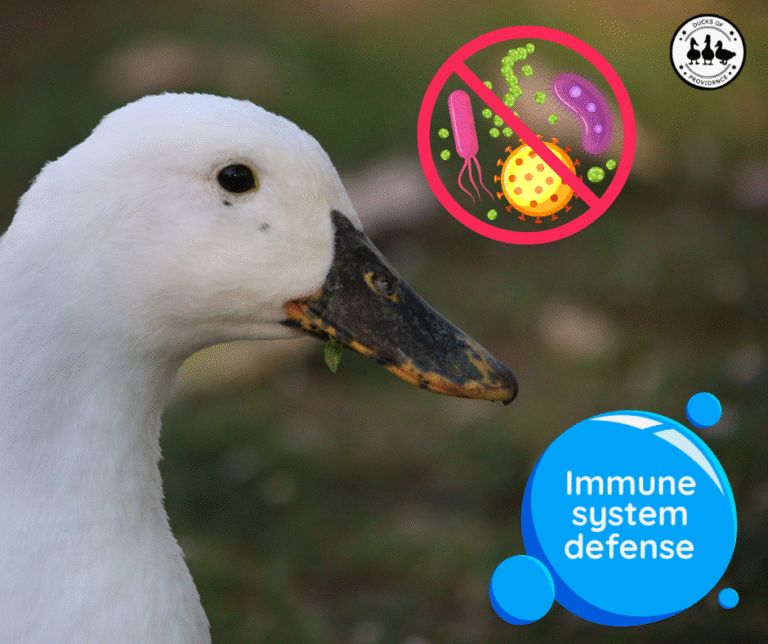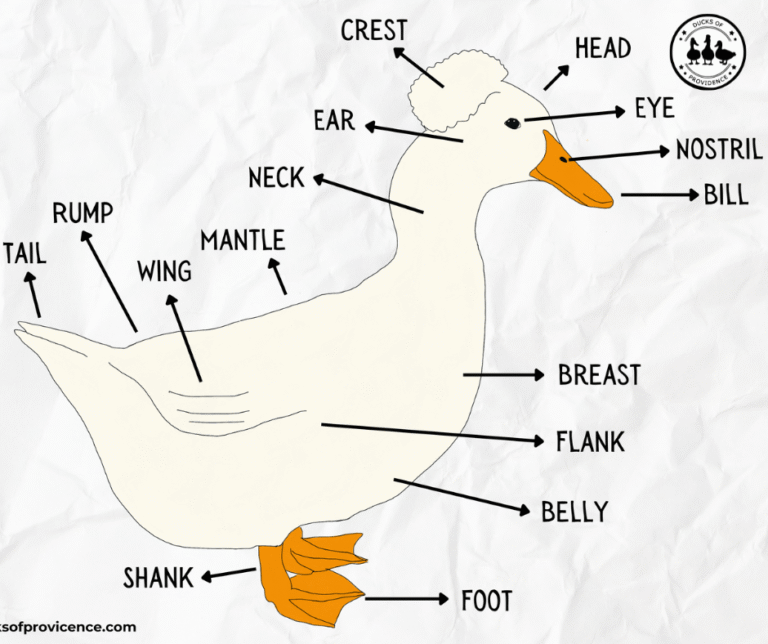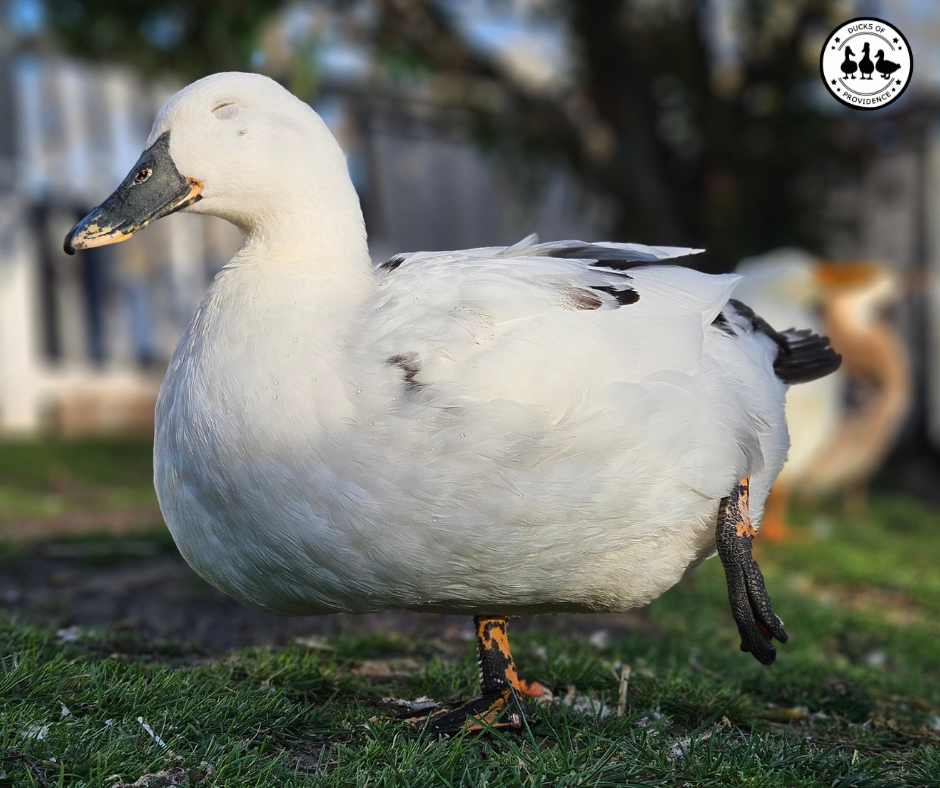
How Ducks Sleep: Brain Hemispheres, Posture, and Safety
Last updated on July 23rd, 2025 at 06:56 pm
Ducks may look peaceful when they nap by the pond or huddle together in the safety of their coop, but their sleep habits are anything but simple. From unihemispheric sleep to sentinel behavior, the way ducks sleep is a fascinating blend of biology and survival instinct. As pet duck keepers, understanding how ducks sleep can help us provide them with a safer and more comfortable environment, day and night.
Ducks of Providence is free, thanks to reader support! Ads and affiliate links help us cover costs—if you shop through our links, we may earn a small commission at no extra cost to you. Thanks for helping keep our content free and our ducks happy! 🦆 Learn more
Ducks Don’t Fully “Turn Off”: Unihemispheric Slow-Wave Sleep
When we sleep, both halves of our brain typically rest together. But ducks, like many other birds, have evolved a fascinating ability known as unihemispheric slow-wave sleep (USWS). This means that only one hemisphere of their brain sleeps at a time, while the other remains awake enough to stay alert for danger. It’s one of nature’s most clever survival tools—and it’s fully active even in our cozy backyard flocks.
During USWS, the sleeping hemisphere exhibits slow-wave activity, which is characteristic of deep, restful sleep, while the awake hemisphere remains in a low-amplitude, more alert state. Most amazingly, ducks can also control which side of the brain stays awake, often depending on where threats might come from. For example, if a duck is resting near the edge of a group, it may close only the eye facing inward (toward the flock) while keeping the outer eye open and scanning the surroundings.
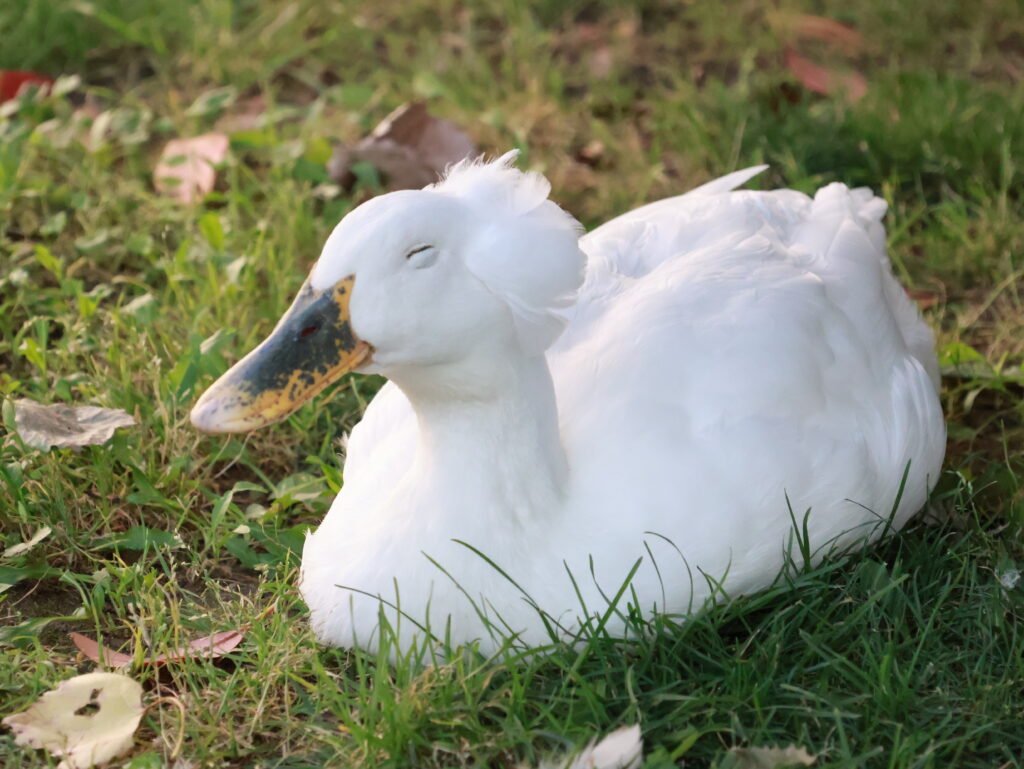
The Science Behind the Sleep
This phenomenon has been extensively studied in birds, especially in ducks. In one classic study, researchers arranged ducks in a row and monitored their brain activity and eye movements. The ducks in the center of the row typically slept with both hemispheres and both eyes closed. However, ducks on the edges frequently slept with one eye open, and only half their brain rested—a clear demonstration of unihemispheric sleep used for predator detection. Even more interestingly, ducks could switch sides during rest to give both hemispheres a chance to recharge.
This type of sleep offers a clear evolutionary advantage in the wild, where constant vigilance can mean the difference between survival and becoming a predator’s next meal. But even in the safety of a backyard coop, many ducks still exhibit this behavior, especially new or anxious ducks, or those lower in the flock’s social hierarchy.
What This Means for Pet Ducks
In our experience, you can often observe unihemispheric sleep in pet ducks if you watch closely, particularly in outdoor settings. One eye may remain slightly open or flutter occasionally, even when the duck appears to be resting. Some ducks—like our more skittish Ronja—are especially prone to keeping an eye open unless she’s tucked in next to her favorite companion.
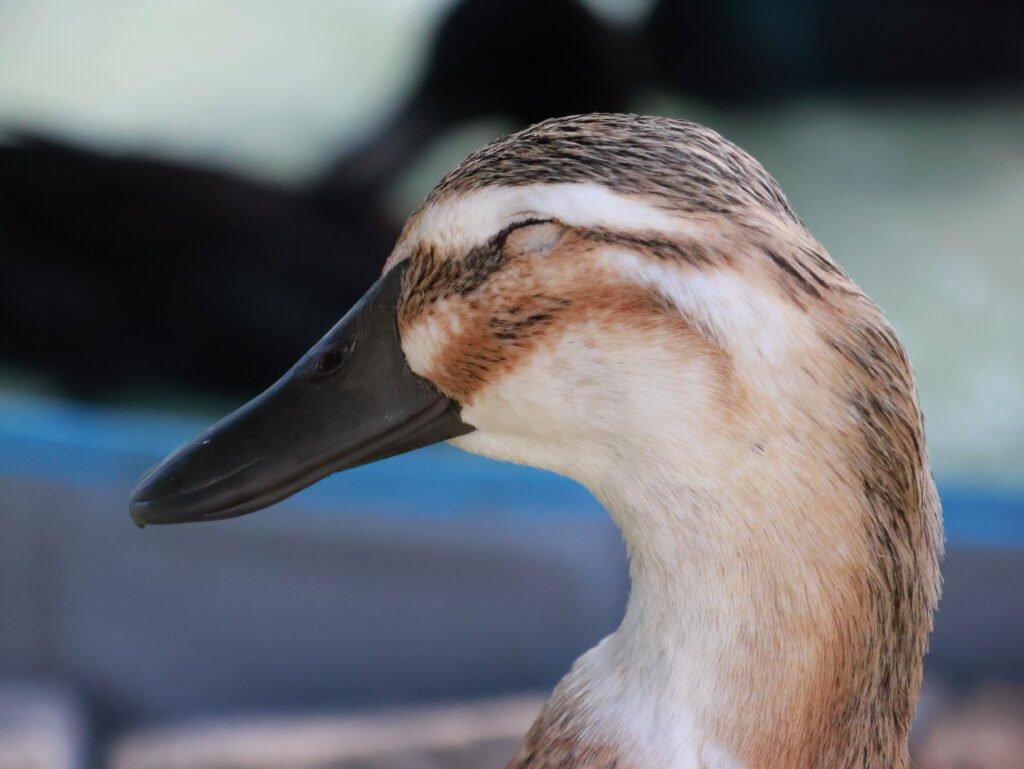
This sleep style also means that ducks need a safe and calm environment to achieve full, bilateral sleep (when both hemispheres rest together). It’s rare, but when your ducks lie down with both eyes shut and show no signs of alertness, they’re in a deeper sleep—and that’s a good sign that they feel secure in their space.
For indoor ducks or those with a trusted human companion, this deep sleep may happen more frequently. We’ve seen our cuddle-duck Muffin fall into such a deep sleep on our lap that she flattens out and snores softly, both eyes shut. In that moment, she’s finally letting both halves of her brain rest—something she may not always feel safe enough to do outside.
The Role of the “Sentinel” Duck
In any flock of ducks, whether wild or domesticated, there’s often an invisible agreement: someone always keeps watch. This behavior, known as sentinel duty, is a key part of how ducks manage to sleep and stay safe at the same time. It’s not just a cute quirk; it’s a highly evolved survival strategy.
In natural settings, ducks tend to sleep in a group formation, often in a line or a huddle. The ducks in the middle typically sleep more deeply with both eyes closed, while the ducks on the edges stay more alert. These edge ducks frequently engage in unihemispheric sleep (as covered above), keeping one eye open and one hemisphere of their brain awake. These “sentinels” are the flock’s early warning system, ready to sound the alarm if a predator approaches.
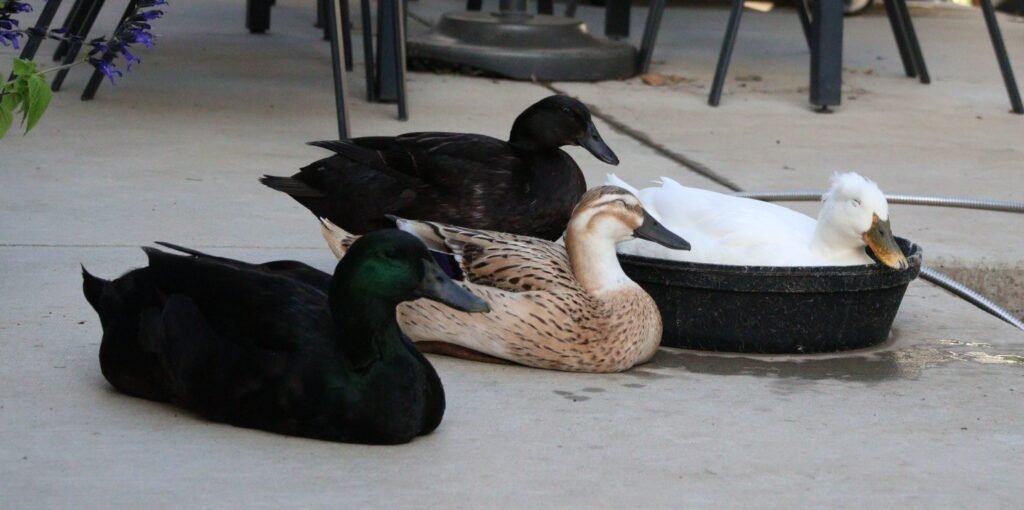
Scientific Backing for Sentinel Sleep
This sentinel behavior was documented in the same 1999 study by Rattenborg et al., published in Nature. The researchers observed that ducks on the periphery of a group not only slept with one eye open but also chose which eye to keep open based on their position in the line; the eye facing away from the group remained open to monitor the surroundings. When the ducks were rotated or switched positions, their sleep behavior adjusted accordingly. This indicated that the behavior was not random but a flexible, strategic choice based on perceived risk.
Sentinel Behavior in Pet Ducks
While our backyard and indoor ducks are far removed from the dangers of the wild, these instincts are still very much alive. If you observe your own flock carefully, especially at night or during naps in the run, you might notice certain ducks always staying a bit more upright or facing the door. These are your natural sentinels, often more skittish or dominant individuals who take on a protective role.
In our flock, Simon—when not in drake jail—often adopts this role, especially if the rest are inside the duck house and he’s outside in the run. Ronja, one of our more cautious girls, is also often found sleeping with one eye open at the edge of a group nap. Meanwhile, ducks like Muffin or Krümel, who are more trusting and bonded to us, tend to settle into the center and sleep more deeply.
Sentinel Rotation and Group Dynamics
Interestingly, ducks rotate the sentinel role, just like shifts in a guard post. This ensures no one duck is sleep-deprived and that every member of the flock gets a chance to rest fully. In a well-functioning flock, this rotation seems to happen seamlessly and without conflict, further highlighting the social intelligence of ducks.
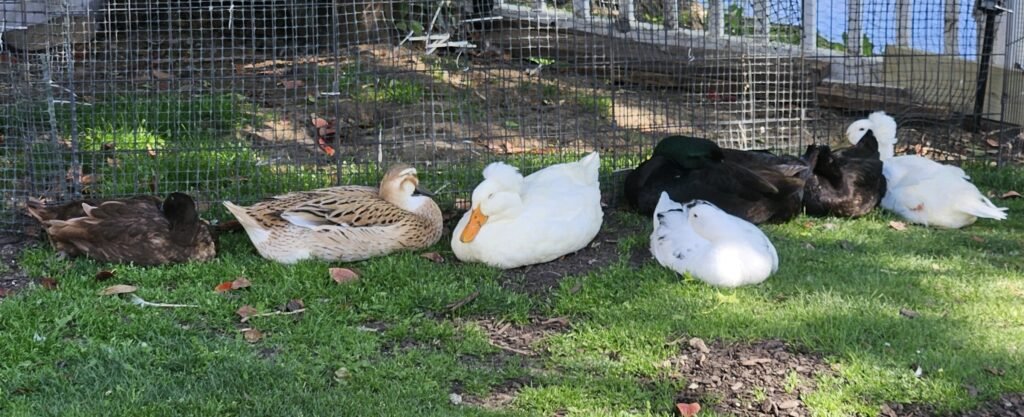
However, in flocks with social tension or bullying, sentinel behavior may become skewed. Lower-ranking ducks might always be pushed to the edge, while more dominant ducks claim the safest sleeping spots. This is one of the reasons why it’s important for us as duck keepers to pay attention to flock dynamics and provide enough space and secure shelter so that all ducks can feel safe and get the rest they need.
Duck Sleeping Positions and Postures
Ducks are masters at adapting their sleeping positions to suit their environment, level of safety, and even the weather. Unlike humans, who generally sleep in one posture in a bed, ducks cycle through a variety of positions, each with its own purpose. Observing how your ducks sleep can actually give you clues about how secure, healthy, and relaxed they feel.
Standing on One Leg
One of the most iconic duck sleeping positions is standing upright on one leg, often with the other leg tucked up into their body. This posture serves several purposes:
- Heat conservation: Ducks lose a lot of heat through their feet. By tucking one foot up into their warm down feathers, they reduce heat loss, especially on cold or damp surfaces.
- Quick escape: Standing allows for rapid movement if needed. A duck can hop or run away instantly if it senses danger.
- Muscle rest and balance training: Alternating legs gives each limb a break while still engaging core balance, which may help maintain muscle tone and flexibility.
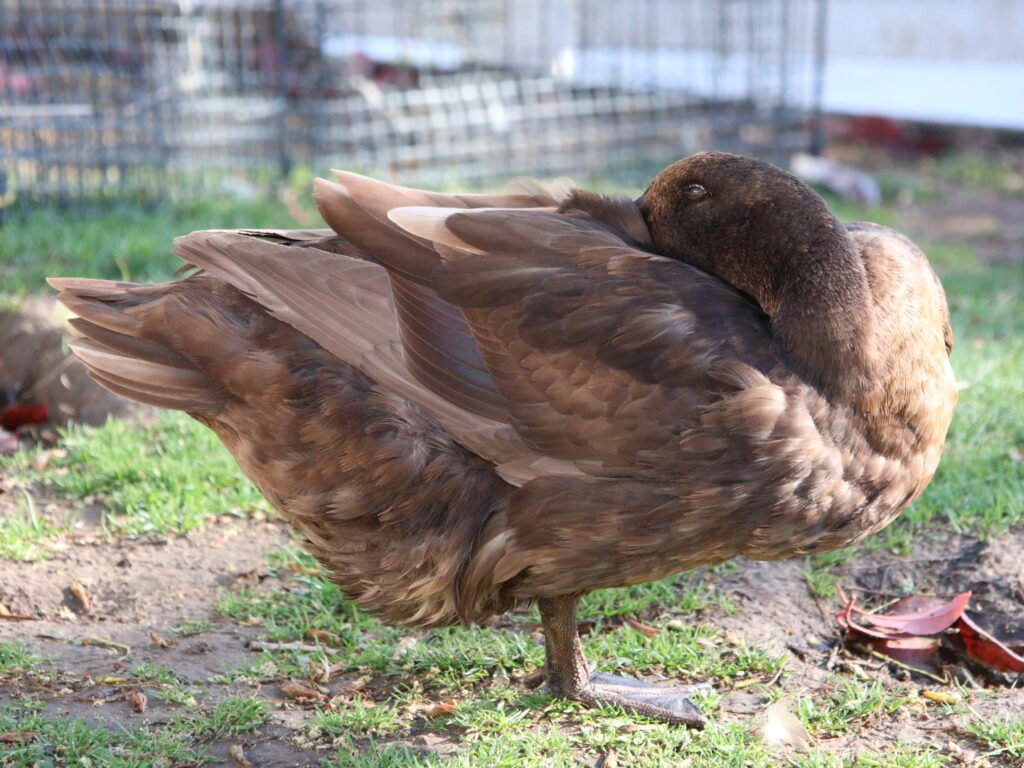
This is a very common posture during daytime naps or in semi-alert environments, like while resting near a food bowl, in an open run, or on a sunny patch of grass.
Head Tucked Under a Wing
A deeply relaxed duck often tucks its bill and head under the feathers on its back or wing. This isn’t just adorable—it’s a sign of deeper, more restorative sleep.
- Neck and head support: Tucking helps reduce strain on the neck muscles.
- Warmth and moisture retention: The head is protected from cold air, and the sensitive nares (nostrils) are shielded from drying out.
- Sensory shutdown: Tucking the head can help dampen external stimuli like light and sound, encouraging full brain rest.
You’ll often see this position used when ducks are in a safe, dark, and familiar spot, like inside the coop or during midday naps in the shade.
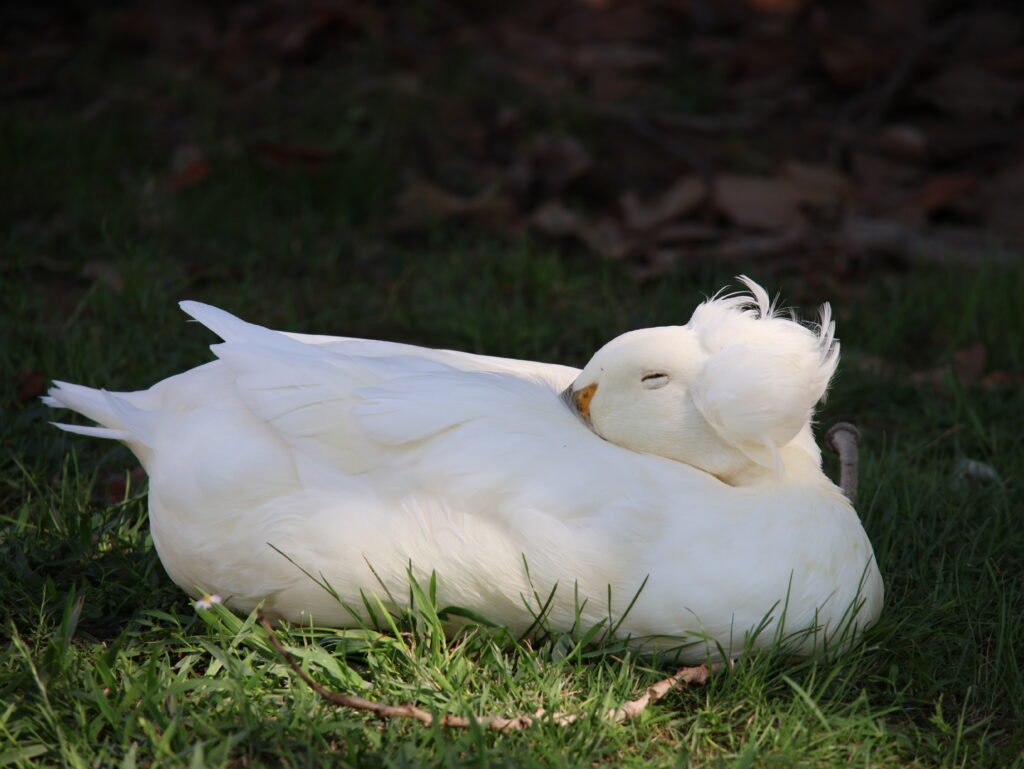
Lying Down Flat
When a duck lies fully down with its legs tucked under and its belly flat against the ground, this is a strong indicator of trust and safety. This position is:
- Energy-efficient for longer rest periods
- Thermoregulating, especially on warm or cool surfaces
- Socially reassuring, as ducks often do this when they huddle in groups
Some ducks will even stretch out their legs and slightly fan their wings to regulate temperature. On hot summer days, it’s common to see ducks lying on shaded concrete, turf, or even shallow water dishes to cool off.

In our flock, this is how we know everyone feels safe for the night—when they’re all snuggled into the bedding in the duck house, lying flat and with their heads tucked, even Simon!
Sprawled or Flopped-Out Feet
Ducks can also sleep lying down with their feet sprawled or flopped out behind them. This position is particularly common in ducklings but is also seen in relaxed adult ducks, especially when they’re resting in a warm, secure environment.
- Sprawled feet are a strong indicator of comfort and safety.
- It’s often seen during naps on soft bedding, warm surfaces, or after swimming.
- Ducklings do this frequently as they’re still developing muscle tone and tend to fully relax when tired.
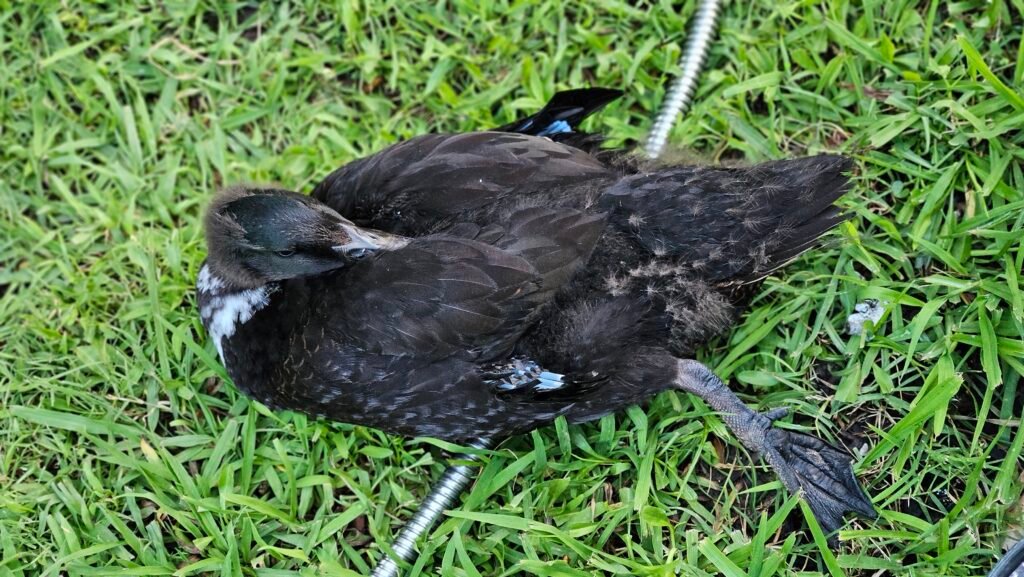
While humans might worry that a duck in this posture is injured or exhausted, it’s generally a normal, healthy behavior in well-rested, content ducks.
Head Positions During Rest
In addition to body posture, ducks also show a variety of head positions while resting:
- Tucked under the wing – the most classic deep-sleep posture.
- Laid flat out in front – often seen during lighter naps, especially in young ducks.
- Bill resting on the ground, tipped downward – as ducks begin to lose muscle tone during deeper sleep, their head may gradually lower, and the bill may touch the ground.
- Head flopped slightly to the side – it’s rare for ducks to lie fully on their side, but the head alone may tilt sideways during especially deep rest.
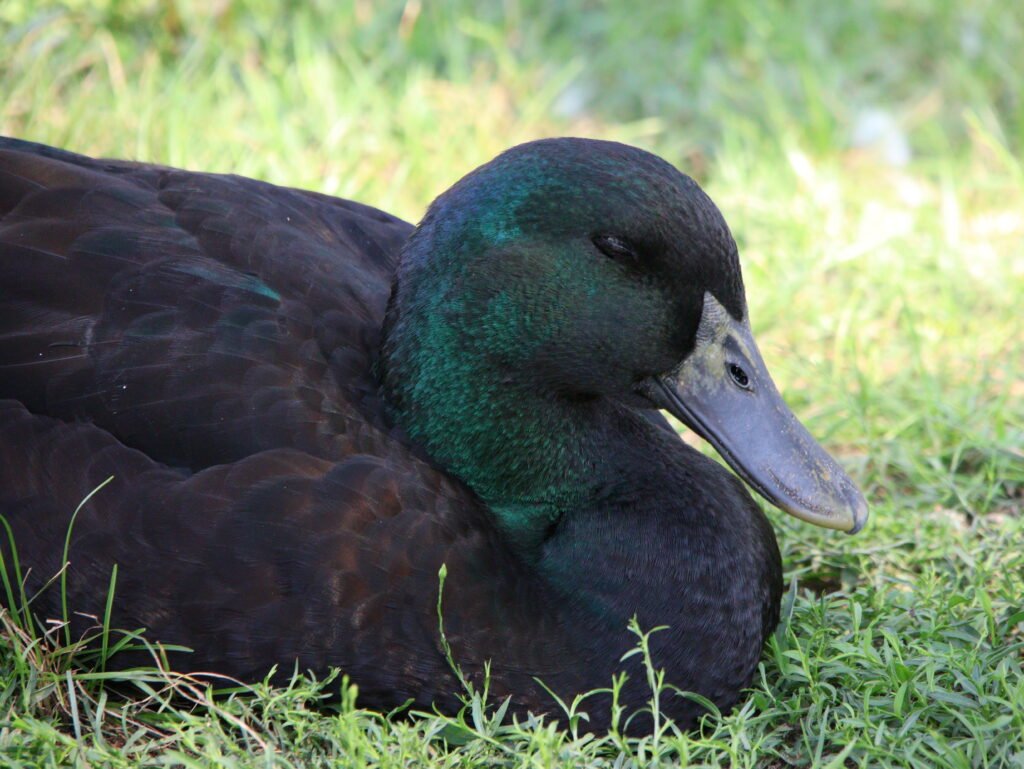
This last position is sometimes mistaken for illness, but in a relaxed, healthy duck, it usually just indicates that they feel completely secure. It’s not as common, but it does happen, especially in indoor ducks or those used to human handling.
We’ve noticed that Muffin, when sleeping in her indoor pen, sometimes lets her little bill tip to the ground as she drifts into deeper rest. It’s always a reminder of how safe she feels inside her cozy space.
Posture as a Health Clue
It’s worth noting that sleep posture can also signal health issues:
- A duck that never lies down may be guarding an injury or dealing with bumblefoot.
- One that constantly sleeps standing and doesn’t move well may have joint pain or mobility problems.
- A duck sleeping too much, fluffed up alone, or awkwardly balanced could be sick and should be observed closely.
This is why it’s so helpful to know your ducks’ normal sleep habits so that you can spot subtle changes early.
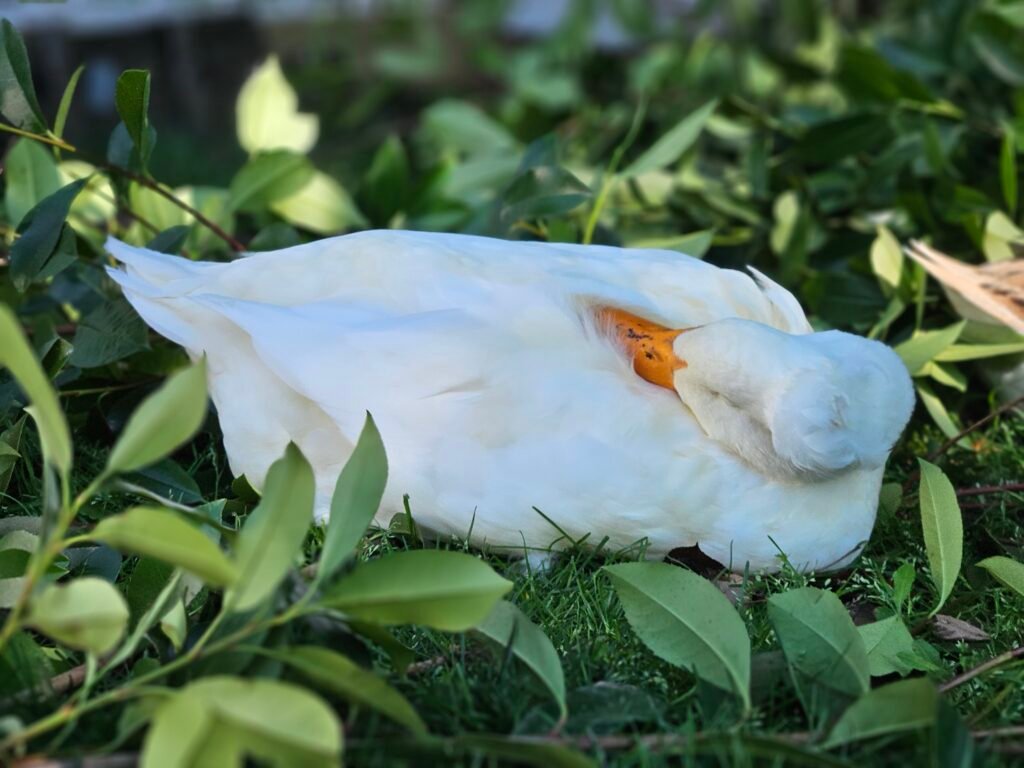
Sleep Patterns: Ducks Are Not Strictly Nocturnal
Unlike owls or raccoons, ducks don’t follow a strict day-night sleep cycle. In fact, ducks are polyphasic sleepers—meaning they sleep in multiple short bouts throughout the day and night, rather than in one long stretch like humans. This flexible sleep pattern is influenced by many factors, including light, safety, social dynamics, weather, and individual temperament.
Polyphasic Sleep Explained
Polyphasic sleep allows ducks to nap as needed, especially when the environment is safe and quiet. These naps may last anywhere from a few minutes to half an hour, and they often occur:
- Midday naps in the shade or sun
- Brief rest periods after foraging or bathing
- Quiet moments in the coop or run
- Longer, deeper stretches at night—if their environment feels secure
In nature, this sleep pattern helps ducks stay alert for predators while still getting the rest they need. Instead of fully shutting down, they take advantage of safe moments to grab restorative sleep in brief segments. But here’s the key insight for duck keepers: even at night, ducks rarely sleep straight through.
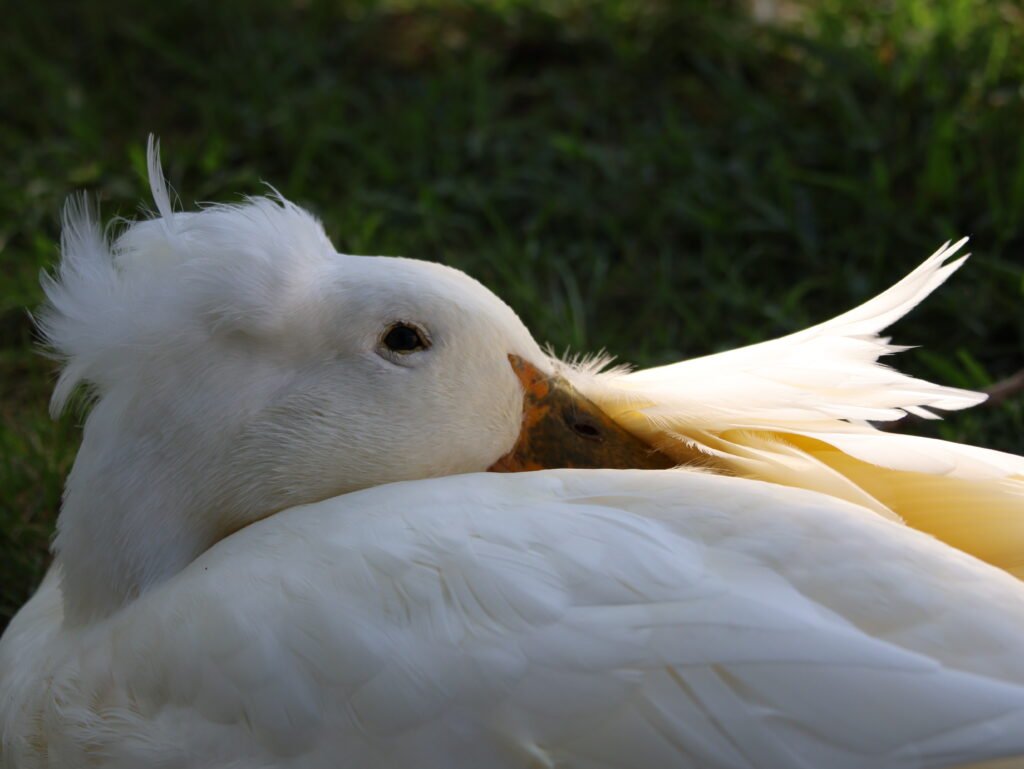
What Does This Look Like in Pet Ducks?
If you observe your flock throughout the day, you’ll notice that ducks don’t just sleep at night. They frequently nap in the sun, in the shade, or while floating peacefully on water. These mini-sleeps are often accompanied by one eye open and the occasional head-tuck under a wing.
At night, they typically sleep for longer and more deeply, especially if you provide a routine and secure environment. In our flock, the ducks begin winding down as dusk falls. Once they’re locked up in their predator-proof duck house, they often lie down, settle into their bedding, and drift into deeper, bilateral sleep (with both brain hemispheres resting).

But even then, they remain light sleepers, ready to wake at any sudden sound or change in their surroundings. A gust of wind, the beam of a flashlight, or an unusual noise can rouse them immediately. Some of our more alert ducks, like Hertha, have been known to wake up at the slightest creak of the door, even in the middle of the night.
Nighttime Wake-Ups: Drinking, Preening, Wandering
Many new duck owners are surprised to learn that ducks often wake up several times throughout the night. This is completely normal and not a sign of a problem. In fact, it’s part of their natural rhythm.
During the night, ducks may:
- Get up to drink water (especially important in warmer months)
- Preen their feathers to stay clean and aligned
- Wander or reposition themselves within the coop
- Briefly vocalize or shift roles in group sleep dynamics
We regularly hear rustling from our duck house at night as someone decides to shuffle over to the water bowl or fluff up their feathers with a vigorous preening session. It’s part of the rhythm of a content flock. As long as the movement isn’t frantic or accompanied by distress calls, it’s perfectly normal.
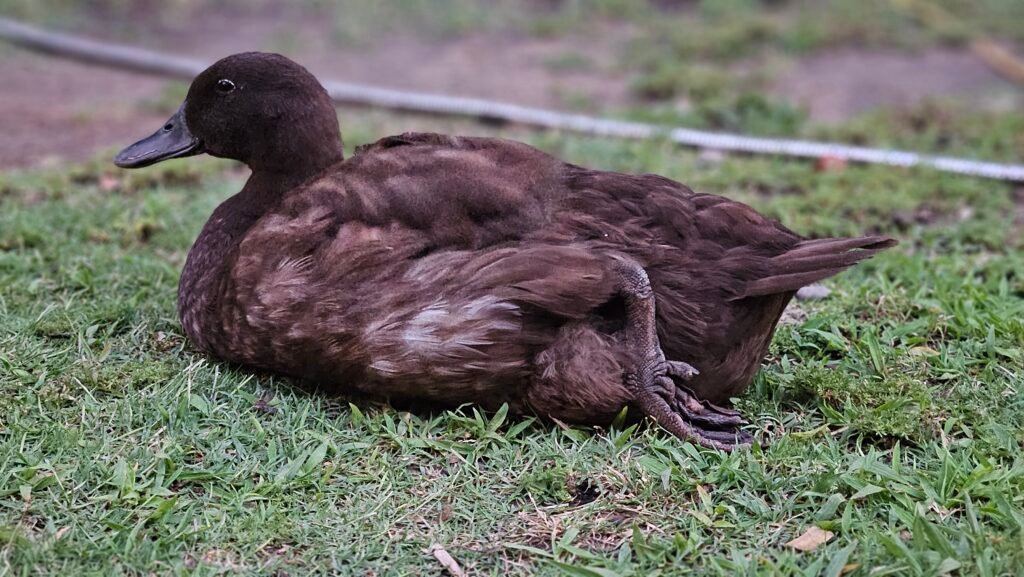
Light, Safety, and Sleep Quality
While ducks sleep in short bursts both day and night, the quality of sleep depends heavily on how safe they feel. A secure, enclosed coop helps them settle into deeper, more restful bilateral sleep, especially during the darker hours. But even in these settings, ducks remain light sleepers, ready to wake up if something seems “off.”
Changes in ambient light, sudden noises, or even the soft hum of a distant animal can trigger a duck to stir or rouse the flock. In our flock, Simon is often the first to perk up and grumble quietly if he hears something outside. Hertha will then stand up and look around, prompting others to momentarily wake as well. Then, just as quickly, they settle again.
Creating a Safe Sleeping Environment for Pet Ducks
Ducks can only sleep deeply when they feel truly safe. While their instincts allow them to remain partially alert through unihemispheric sleep, it’s our job as duck keepers to create a space where they can relax enough to rest fully and comfortably. A well-designed sleeping area supports not only rest but also the overall health, stress reduction, and emotional well-being of your flock.
Here’s what to consider when setting up the ideal duck sleeping environment:
| Tip | Why It Matters |
|---|---|
| Ensure water access overnight | Ducks wake to drink, make sure clean water is available. |
| Use dry, soft bedding | Encourages comfortable rest, whether lying down or standing. |
| Keep nighttime lighting minimal | Helps ducks distinguish day from night and settle properly. |
| Let them nap during the day | Don’t worry if your ducks take several short daytime naps, that’s their normal. |
| Watch for changes in sleep behavior | Excessive sleep, reluctance to settle, or isolation during rest may signal illness or stress. |
| Establish a consistent bedtime routine | Ducks feel more secure and sleep more deeply when they know it’s time to settle in. |
| Predator-proof coop | Keeps ducks feeling secure enough to sleep more deeply. |
Predator-Proof Coop: Peace of Mind for You and Your Ducks
Predator safety is the single most important factor. Even the slightest hint of danger—like the scent of a raccoon, the sound of a dog, or a light outside the coop—can prevent ducks from resting properly. A secure coop:
- Reduces stress and fear-based vigilance
- Allows for bilateral sleep (when both brain hemispheres rest)
- Helps maintain healthy immune and reproductive systems
What to include:
- Solid walls and flooring (no gaps)
- Latching doors that lock securely
- Hardware cloth (preferably 1/2″ or 1/4″) over windows or vents
- Predator apron or buried wire around the base
- Interior barriers to block drafts without limiting ventilation
We always make sure our duck house is locked up at sunset and check all latches every night. After a near-miss with a raccoon early in our duck-keeping journey, we’ve never taken night safety lightly again.
Clean, Dry Bedding
Comfortable bedding encourages ducks to lie down fully and sleep more deeply. Wet or compacted bedding not only discourages rest but also increases the risk of respiratory issues, infections, or bumblefoot.
Recommended options:
- Pine shavings (absorbent, soft, and affordable)
- Straw (cozy but can be harder to clean)
- Hemp bedding (low dust, compostable, excellent odor control)
- Avoid cedar shavings due to respiratory concerns
We personally use pine shavings for their balance of softness and absorbency. For indoor ducks like Krümel, we sometimes switch to towels when monitoring health overnight—easier to check droppings and keep dry.
Space and Social Layout
Ducks are social sleepers, but they still need enough space to rest without crowding. Overcrowding can lead to squabbles, pecking, and stress, especially during warm weather when they spread out more.
- Plan for at least 4–6 square feet per duck inside the coop
- Include flat floor space with no elevated perches (ducks don’t roost like chickens)
- If your flock has social tension, provide corners or dividers so timid ducks can rest undisturbed

We’ve noticed that our ducks naturally gravitate to certain spots every night—Krümel and Muffin cuddle together, while Penny likes to curl up by herself. Designing the sleeping area with multiple comfortable zones helps everyone get the rest they need.
Access to Water (But Not Soaked Bedding)
Ducks wake up during the night to drink, so it’s important to provide access to clean water, even after bedtime. However, placing water inside the coop can lead to soggy bedding if not carefully managed.
Tips:
- Use heavy, spill-resistant bowls or gravity waterers
- Place bowls on a rubber mat, shallow tray, or tile surface to catch drips
- Consider setting up a small overnight water station just outside the sleeping area if indoor access isn’t practical
In our coop, we place a shallow water dish in the corner on a boot tray to prevent mess. It gives the ducks what they need without compromising their dry sleeping space.
Darkness and Routine
Ducks are light-sensitive and respond well to a regular bedtime routine. They naturally wind down as the sun sets, but artificial lighting or irregular patterns can confuse their internal clock and disrupt sleep.
- Keep sleeping areas dim or fully dark at night
- Avoid turning on lights after they’ve settled in
- Establish a consistent lock-up time to reduce nighttime stress
We’ve found that closing the coop at dusk every night helps our ducks settle down peacefully—and they now wait by the door when they know it’s bedtime.
Final Thoughts
Ducks may not sleep like we do, but once you understand their rhythms, instincts, and sleep behaviors, it’s easy to see how beautifully adapted they are for balancing rest with survival. From their ability to sleep with one eye open to the way they rotate sentinel roles in the flock, duck sleep is a fascinating blend of neuroscience and natural behavior—and it’s something we as duck keepers can support every single day.
Whether they’re napping in the afternoon sun with one foot tucked, preening quietly in the moonlight, or huddled together in a safe coop at night, ducks need—and deserve—a place where they feel protected enough to rest fully. The better we understand how they sleep, the more we can tailor our care to support both their physical and emotional well-being.
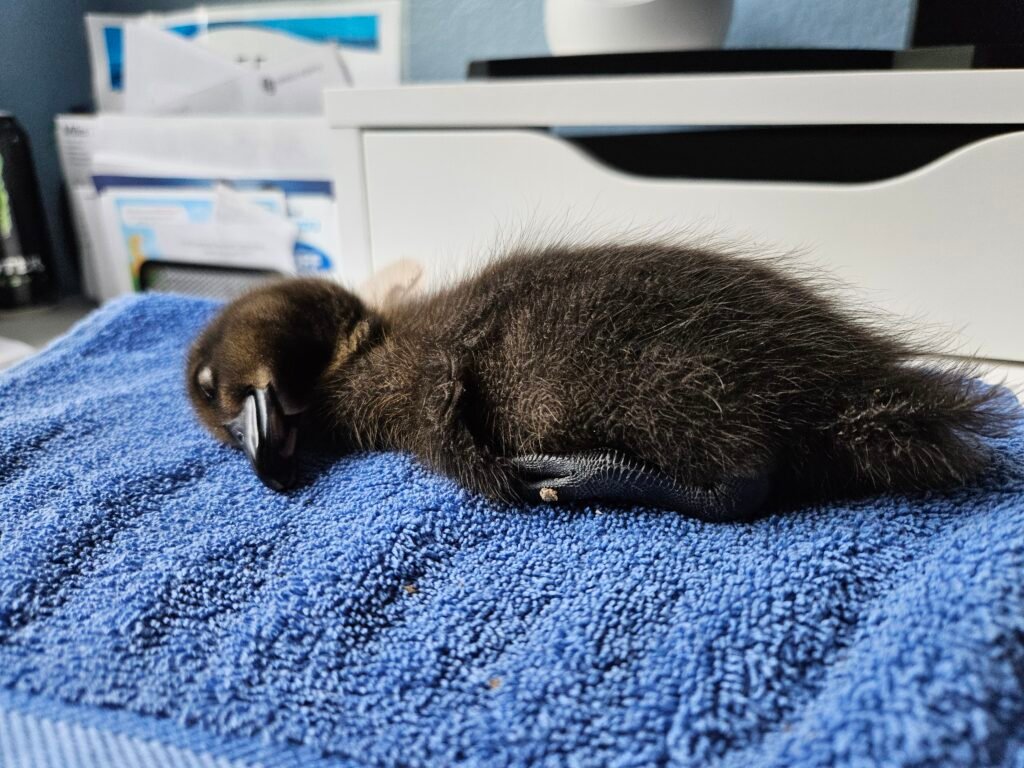
We’ve seen firsthand how the quality of a duck’s sleep environment can influence not just their rest, but their mood, their health, and even their relationships with one another. When Krümel curls up with Muffin in her favorite spot and finally tucks her head under her wing, we know she feels safe—and that’s all we can ask for as duck parents.
So whether your ducks live indoors, in a backyard coop, or free-range under watchful eyes, take a moment to observe how they sleep. Their postures, patterns, and even the positions they choose in the flock all tell a story—and when ducks sleep well, it’s a sign that they trust the world around them.
Because a well-rested duck is a happy duck.
Related Articles
- Creating the Perfect Home for Your Pet Ducks: Housing, Space, and Safety Tips
- How to keep your ducks safe from predators?
- Ducks and Water: Keeping Your Flock Happy and Healthy
- What is the Best Bedding for Ducks?
- Duck Eye Facts: How Ducks See the World Differently

